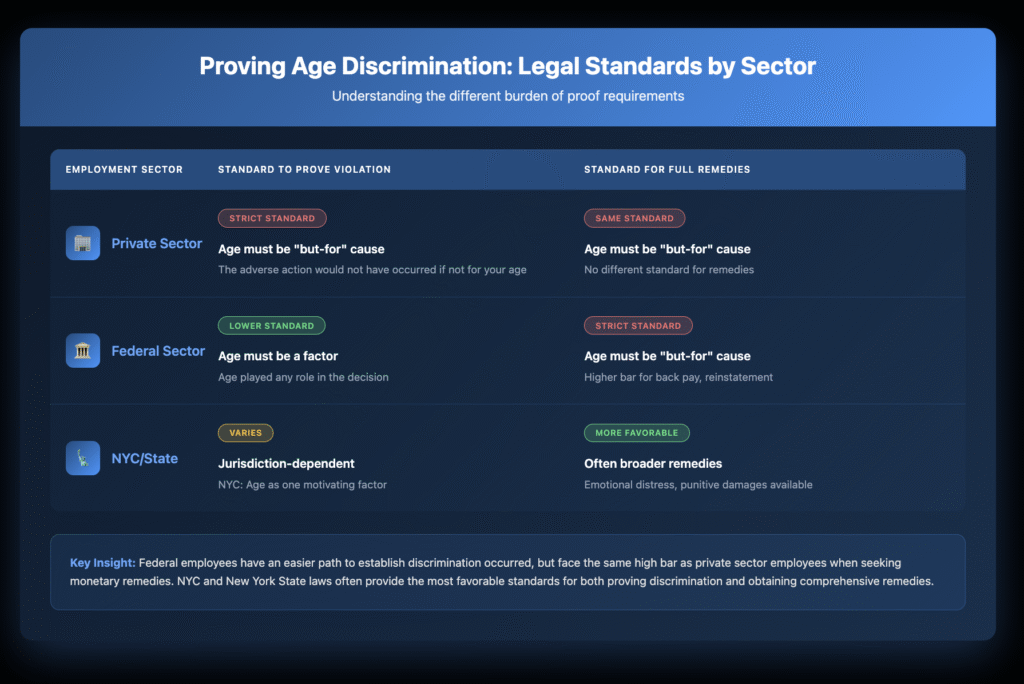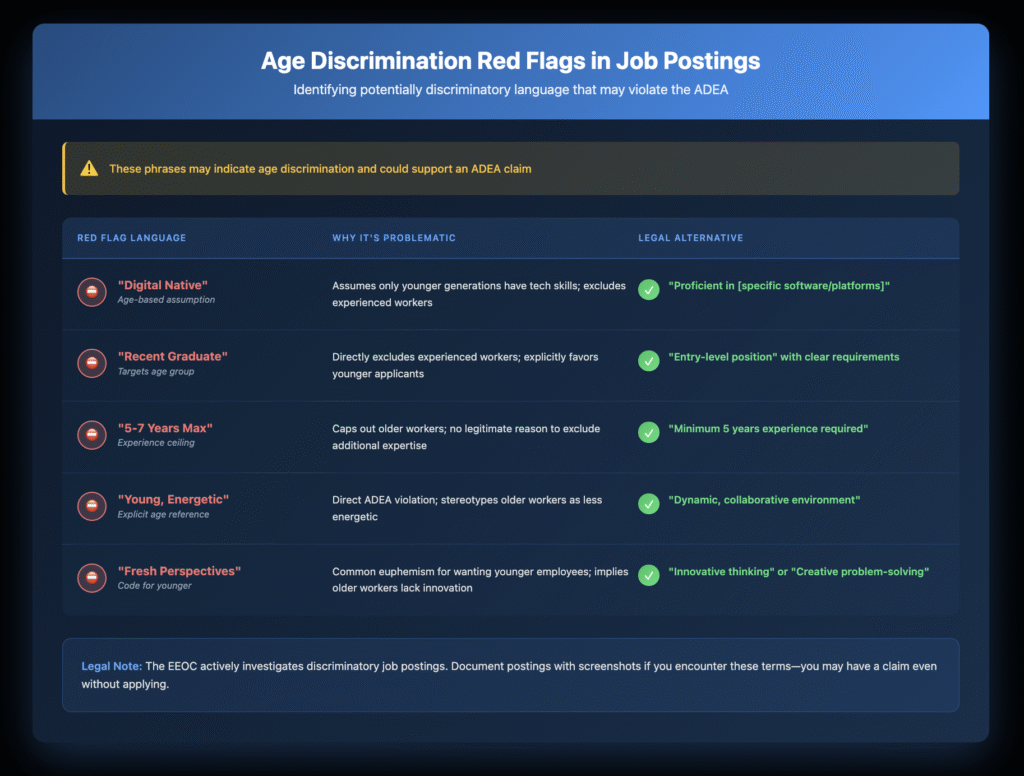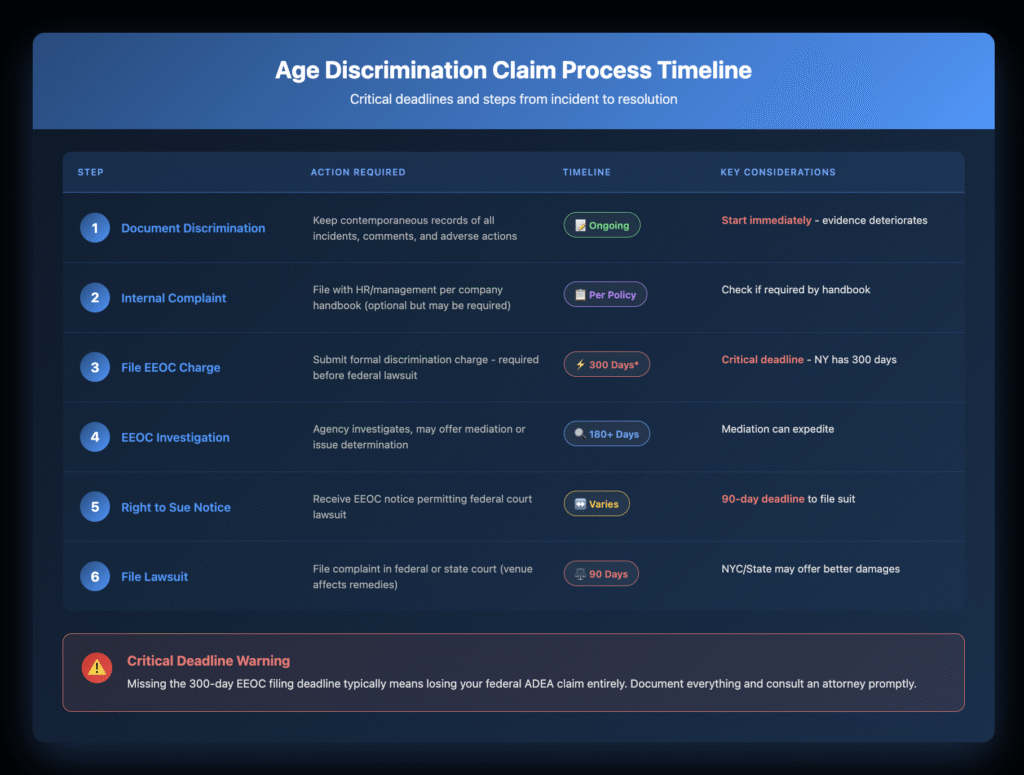Recent Supreme Court decisions have fundamentally reshaped age discrimination law, creating a challenging “but-for” causation standard that requires workers 40 and older to prove age was THE determining factor—not just one factor—in adverse employment actions like termination or demotion. The 2009 Gross v. FBL Financial Services ruling established this high bar for private sector employees, while the 2020 Babb v. Wilkie decision gave federal workers a slightly easier path to prove discrimination occurred (though they still need to meet the strict standard for full remedies).
These landmark cases mean you need stronger evidence than ever—documented age-related comments from decision-makers, proof that younger employees received better treatment, and clear connections between age bias and employment decisions. With EEOC filing deadlines as short as 300 days and success rates hovering around 15-20% for settlements, understanding these legal standards and acting quickly with proper documentation is crucial for protecting your career after 40.
If you’re over 40 and facing sudden performance issues, retirement pressure, or exclusion from opportunities after years of success, you might be experiencing age discrimination. The legal landscape for age-based workplace discrimination has been shaped by significant Supreme Court decisions that affect how these cases are proven, what evidence matters, and what remedies you can pursue.
Understanding these legal standards helps you recognize illegal discrimination and protect your rights. This guide breaks down the most important Supreme Court cases and their practical impact on your workplace protections.
Disclaimer: This article provides general information for informational purposes only and should not be considered a substitute for legal advice. It is essential to consult with an experienced employment lawyer at our law firm to discuss the specific facts of your case and understand your legal rights and options. This information does not create an attorney-client relationship.
Key Takeaways
- The “but-for” standard is tough: Since Gross v. FBL (2009), you must prove age was THE reason—not just A reason—for your termination or demotion
- Federal employees have a split advantage: They can more easily prove discrimination occurred but still need to meet the strict standard for monetary remedies (Babb v. Wilkie, 2020)
- Documentation from decision-makers matters most: Age-related comments from supervisors with firing authority carry more weight than colleague remarks
- You have 300 days to file with the EEOC in New York—missing this deadline usually means losing your federal claim entirely
- NYC and NYS laws offer stronger protections: Lower causation standards, longer filing periods, and additional damages including emotional distress
- Settlement ranges vary widely: While median EEOC settlements are $40,000-$60,000, strong cases can achieve much higher awards
- New threats emerging: AI hiring tools and “digital native” job postings may encode age bias through indirect screening methods
What Do You Need to Prove in an Age Discrimination Case?
The Age Discrimination in Employment Act (ADEA) protects workers 40 and older from employment discrimination. But here’s the challenge: since the Supreme Court’s 2009 Gross v. FBL Financial Services decision, you must prove age was the “but-for” cause of the adverse action—not just one factor among many.
This means showing the termination, demotion, or denial of promotion wouldn’t have occurred if you were younger. It’s a higher bar than other types of discrimination claims, where showing bias was just one motivating factor can be enough.
How Do Federal and Private Sector Standards Differ?
The 2020 Babb v. Wilkie‘s decision created an important distinction. Federal employees face a lower threshold to establish that discrimination occurred—they need only show age was a factor in the decision. However, to get remedies like back pay or reinstatement, even federal workers must meet the stricter “but-for” standard.

Which Landmark Supreme Court Cases Are Shaping Age Discrimination Law?
How Did Gross v. FBL Financial Services (2009) Change the “But-For” Standard?
Gross fundamentally altered age discrimination litigation by establishing that ADEA plaintiffs must prove age was the determinative factor in the adverse employment action. Unlike Title VII claims for race or sex discrimination, showing that age was merely one motivating factor isn’t enough.
This heightened causation standard means you need stronger evidence to succeed. Documentation showing age was THE reason—not just A reason—for your termination or demotion becomes crucial. The practical impact? Employers can argue other factors (performance, restructuring, personality conflicts) were the real reasons, even if age played some role.
What Different Path Did Babb v. Wilkie (2020) Create for Federal Workers?
The Supreme Court recognized that federal employees operate under different statutory language. The federal-sector provision of the ADEA requires personnel decisions be made “free from any discrimination based on age.”
This creates a two-tier system where federal employees can more easily establish if a violation occurred, but still need to meet the “but-for” standard for monetary remedies. It’s a partial victory—federal workers can prove discrimination more easily but face the same uphill battle for back pay or reinstatement.
What Are the Potential Implications of Bostock v. Clayton County (2020)?
While Bostock addressed sex discrimination, not age, its reasoning could influence future ADEA interpretation. The Court emphasized that discrimination occurs when someone is treated differently because of a protected characteristic, even if other factors also contributed.
Legal scholars debate whether Bostock’s logic challenges Gross’s strict “but-for” standard. The tension between these decisions remains unresolved, but it represents an area to watch as lower courts grapple with reconciling these approaches.
How Does Comcast Corp. v. National Association of African American-Owned Media (2020) Reinforce Strict Standards?
This unanimous decision reinforced that “but-for” causation must be proven throughout litigation, including at the pleading stage. While addressing racial discrimination in contracting, the Court’s commitment to strict causation standards suggests the challenging Gross standard for age claims will persist.
The message is clear: courts require concrete evidence of causation from the start. Vague allegations or circumstantial suggestions of age bias won’t survive initial motions to dismiss.
What Are Common Age Discrimination Scenarios?
What Constitutes a Hostile Work Environment Based on Age?
Creating a hostile work environment claim based on age requires showing severe or pervasive harassment that alters workplace conditions. Age-related comments must go beyond isolated jokes or offhand remarks to create an abusive environment.
To establish this claim, document:
- Frequency of age-related comments
- Who made them (supervisors carry more weight)
- Impact on your work performance
- Connection to tangible employment actions
What Is the “Retirement Discussion” Pattern?
Persistent retirement inquiries can signal age discrimination, especially when followed by:
- Reduced responsibilities
- Exclusion from long-term projects
- Sudden performance criticism
- Transfer of duties to younger employees
While asking about retirement plans isn’t automatically illegal, patterns connecting these discussions to adverse actions can support discrimination claims. Document when these conversations occur and any changes in treatment that follow.
What Emerging Threats Do AI and Experience Caps Pose?
How Does Algorithmic Age Discrimination Work?
Artificial intelligence hiring tools may encode age bias through proxies—screening out applicants based on graduation dates, technology preferences, or career patterns more common among older workers. While case law is still developing, the EEOC has begun investigating AI platforms for potential disparate impact on protected groups.
What Are “Digital Native” and Experience Cap Red Flags?
Job postings seeking “digital natives” or capping experience at 5-7 years effectively screen out older workers. The EEOC increasingly targets these practices as potential ADEA violations, even without explicit age references.

How Do You Build Your Age Discrimination Case?
Why Should You Document Everything—But Focus on Decision-Makers?
Courts give greatest weight to age-related comments from people with firing or promotion authority. A supervisor’s “we need new blood” comment carries more weight than a colleague’s age joke.
Create a detailed log including:
- Date, time, and location of incidents
- Exact words used (not paraphrasing)
- Witnesses present
- Your response and any follow-up
- Connection to employment decisions
How Do You Identify Younger Comparators?
Successful ADEA claims often hinge on showing younger employees received better treatment. Document specific comparators with similar:
- Job titles and responsibilities
- Performance ratings
- Qualifications and experience
- Reporting relationships
The comparison should show the younger employee was treated more favorably under similar circumstances.
What's the Timeline From Incident to Resolution?

*In New York, you have 300 days due to state agency partnership
What Are Realistic Expectations for Damages and Settlements?
What Can You Recover?
ADEA damages include:
- Back pay: Lost wages from termination/demotion
- Front pay: Future lost earnings if reinstatement isn’t feasible
- Liquidated damages: Double back pay for willful violations
- Attorney’s fees: If you prevail
- Emotional distress: Under state/local laws only
Unlike other discrimination claims, the federal ADEA doesn’t allow punitive or emotional distress damages. This limitation makes state and city claims particularly important in New York.
What Are Settlement Realities?
Most age discrimination cases settle before trial. Factors affecting settlement value:
- Strength of evidence (especially decision-maker statements)
- Lost wages and time to find comparable employment
- Whether termination occurred vs. failure to promote
- Employer’s litigation history and reputation concerns
- Available insurance coverage
While median EEOC settlements range from $40,000-$60,000, cases with strong evidence can result in significantly higher awards at trial. Success often depends on documenting clear connections between age-related comments and adverse employment actions.
How Can You Protect Yourself Proactively?
What Should You Do Before Problems Arise?
Smart employees protect themselves before discrimination occurs:
- Save performance reviews: Keep copies at home, especially positive ones
- Document your value: Track achievements, awards, and contributions
- Build your network: Maintain relationships that could provide references
- Know your rights: Understand company policies and legal protections
- Update your resume: Include recent accomplishments and training
What Steps Should You Take When You Suspect Discrimination?
If you’re experiencing potential age discrimination:
- Start documenting immediately using the evidence checklist above
- Review company policies on discrimination and complaint procedures
- Consider internal complaints but understand risks and benefits
- Consult an attorney before making major decisions
- Preserve evidence including emails, texts, and documents
- Meet deadlines for EEOC filing and internal complaints
What's the New York Advantage for Stronger Local Protections?
New York State and New York City human rights laws provide broader protections than federal law:
- Lower causation standard: Age need only be one factor, not the sole cause
- Smaller employer coverage: NYC law covers employers with 4+ employees
- Longer statute of limitations: Three years for NYC claims
- Additional damages: Emotional distress and punitive damages available
- Broader hostile environment standard: Single severe incident may suffice
These enhanced protections make pursuing state and city claims alongside federal ADEA claims strategically important.
How Has COVID-19 Affected Age Discrimination?
The pandemic raised new age discrimination issues. Policies treating older workers differently due to perceived COVID vulnerability may violate the ADEA. However, requesting accommodations based solely on age-related COVID risk, without an underlying medical condition, may not trigger ADEA protection.
The key distinction: neutral safety protocols that happen to benefit older workers are generally legal, while policies explicitly targeting workers based on age are not. Document any age-specific policies or comments about older workers being “high risk” that affect employment decisions.
What's the Bottom Line for Your Rights?
Age discrimination law continues evolving through Supreme Court decisions, but your fundamental right to fair treatment regardless of age remains protected. While the “but-for” causation standard presents challenges, strategic use of federal, state, and local laws can overcome these obstacles.
Success requires understanding the legal standards, documenting discrimination carefully, and acting within required timeframes. The Supreme Court’s Gross decision makes federal claims challenging, but don’t let that deter you—many successful age discrimination cases combine federal, state, and local claims for maximum leverage.
Don’t let age discrimination derail your career. If you’re facing retirement pressure, sudden performance issues, or exclusion from opportunities because of your age, you have options.
How Can You Take Action to Protect Your Career?
Time limits for age discrimination claims are strict, and waiting can mean losing your rights. If you believe you’re experiencing age discrimination in the workplace:
- Document everything immediately
- Understand your filing deadlines
- Consider all available legal protections
- Get experienced legal guidance
At Nisar Law Group, we help employees navigate complex age discrimination claims and pursue the remedies they deserve. Contact us today for a confidential consultation to discuss your situation and explore your options for protecting your career and securing fair treatment.
Related Resources
- Age Discrimination in the Workplace: Complete Guide
- Understanding the Age Discrimination in Employment Act (ADEA)
- Proving Age Discrimination: Evidence You Need
- Age Discrimination During the Hiring Process
- Age-Related Comments: What Constitutes Evidence
- Filing an Age Discrimination Claim: Step-by-Step Process
Frequently Asked Questions About Age Discrimination
Gross v. FBL Financial Services (2009) is the most significant modern age discrimination case. The Supreme Court ruled that plaintiffs must prove age was the “but-for” cause of the adverse employment action—meaning the termination or demotion wouldn’t have happened if not for the employee’s age. This created a higher bar than other discrimination claims, where showing bias was just one factor can be enough. More recently, Babb v. Wilkie (2020) gave federal employees a slightly easier path by requiring only that age be “a factor” to establish discrimination occurred, though they still need to meet the “but-for” standard for full remedies.
Age discrimination settlements vary widely based on lost wages, emotional distress (in state cases), and case strength. While median EEOC settlements hover around $40,000-$60,000, cases that go to trial can result in much larger awards. Factors affecting value include salary level, time to retirement, strength of discriminatory statements from decision-makers, and whether you pursue federal or state claims. New York laws allow emotional distress and punitive damages that federal ADEA claims don’t, potentially increasing settlement values.
Age discrimination cases face unique challenges due to the “but-for” causation standard—you must prove age was THE reason for the adverse action, not just one factor. Your chances improve significantly with: documented age-related comments from decision-makers, evidence of younger employees receiving better treatment, sudden performance issues after years of positive reviews, and statistical patterns showing age-based decisions. Having an experienced attorney who understands how to build evidence meeting the “but-for” standard is crucial.
Common real-world scenarios include: A 58-year-old manager with excellent reviews suddenly placed on a performance improvement plan after their supervisor mentions wanting “fresh blood” in leadership. During layoffs, all employees over 50 are terminated while younger workers with poor performance are retained. Job postings seeking “digital natives” or capping experience at 5-7 years. Persistent questions about retirement plans followed by reduced responsibilities and exclusion from long-term projects. These situations become actionable when you can connect age-related comments or patterns directly to adverse employment decisions.
To pursue an ADEA claim, you must meet these criteria: You’re 40 or older (protected class under federal law). Your employer has 20+ employees (for federal claims; NYC law covers employers with 4+ employees). You experienced an adverse employment action (termination, demotion, denial of promotion). You can show age was the “but-for” cause of the action. You file an EEOC charge within 300 days of the discriminatory act (in New York). Evidence should include documentation of age-related comments, comparative treatment of younger employees, and any sudden change in how you’re evaluated.
Under federal law since Gross v. FBL Financial Services, you must prove age was the “but-for” cause—the adverse action wouldn’t have occurred if you were younger. This is harder than proving race or sex discrimination, where showing bias was one motivating factor suffices. You’ll need evidence like: direct statements about age from decision-makers, statistical patterns (only older workers laid off), comparator evidence (younger employees with similar performance kept), timing (adverse action following age-related comments), and pretext (employer’s stated reason doesn’t hold up). New York State and NYC laws use a more favorable “motivating factor” standard, making local claims strategically important.
Start documenting immediately—keep detailed records of age-related comments, who made them, when, and any witnesses. Save performance reviews, especially positive ones, at home. Identify younger employees in similar roles who receive better treatment. Follow internal complaint procedures if required by your handbook. File an EEOC charge within 300 days—this preserves your rights even if you’re still employed. Consult an employment attorney early for strategic guidance. Consider whether to pursue federal, state, or city claims based on available remedies. Don’t sign anything without legal review.
The EEOC finds “reasonable cause” in only about 2-3% of charges filed. However, this doesn’t mean your case lacks merit—the EEOC has limited resources. Even without an EEOC cause finding, you can still sue successfully. The real value of EEOC filing is that it’s required before federal court and often leads to mediation where many cases settle. About 15-20% of EEOC charges result in some benefit to the charging party through settlement. Your chances improve dramatically with strong documentation and legal representation during the EEOC process.
Have more questions about your potential age discrimination claim? Each situation is unique, and understanding how these legal standards apply to your specific circumstances is crucial. Contact Nisar Law Group for a confidential consultation to discuss your workplace rights and explore your options for holding your employer accountable.


